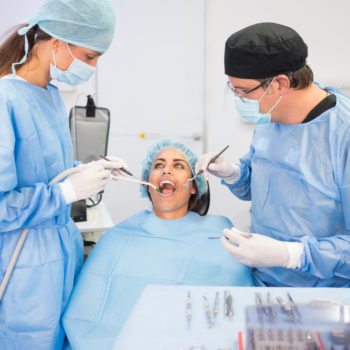Why We Love It
-
$69,960Potential Avg. Salary
-
21.7%Job Growth Rate
-
Growing DemandJob Outlook
-
Growing IndustryCareer Attribute
Prosthetists are responsible for designing or creating artificial devices or prostheses that closely resemble a patients’ missing body part such as a limb. You would closely examine the individual needs of every patient and help them attain their goals with customized and easy-to-use prosthesis. Prosthetists may work in both orthotics and prosthetics, or they may choose to specialize in one particular area. deformities.
Recommended Schools
What is a Prosthetist?
Duties
The duties of a prosthetist involves the following main points:
- Interact with patients with the intention of understanding their requirements and explaining how best to care for their prostheses.
- Create a mold of the patient’s body part and create a prosthetic device with the use of computer modelling technology.
- Design and fit surgical prostheses like artificial limbs (arms, hands, legs, and feet) as closely as possible to the missing limb.
- Regularly update patient records on diagnosis and treatment given
Day in the life
Usually, during their daily tasks, a prosthetist works with a variety of people who might have missing limbs due to birth defects, military injury or accident and amputation due to disease or other medical conditions. The goal of prosthetists is to assess a patient’s needs and help them find prosthetic support to ease their medical problem and facilitate ease of movement. You may have to travel between one appointment to another.
Tasks during the day can involve creating a customised model of the area where the prosthesis will be put. Adjustments will need to be done to ensure the patient’s comfort and best possible performance.
Work schedule and typical hours
Prosthetists work in standard offices indoors where they have appointments with patients and oversee the designs of prostheses. Work hours can extend to 40 hours a week from Monday to Friday.
One has to be prepared to work nights, evenings and over weekends as per workload and deadlines. Prosthetists may occasionally be exposed to health or safety hazards when handling certain materials, but there is little risk of injury if proper procedures are implemented.
Growth of the job
Employment of prosthetist is estimated to grow 23 percent from 2014 to 2024. The aging population and increased occurrence of medical conditions (i.e. diabetes and cardiovascular disease) that affect the human body, will lead to more opportunities in this sector for aspiring prosthetists.
There are better job prospects for prosthetists who hold professional certification. Advances in modern technology increasing the likelihood of people surviving traumatic accidents and suffering from serious injuries. Patients that are victims of severe trauma such as accident victims or military veterans, will require the support of prosthetists to craft specially suited devices that aid in their movement and promotes normal functioning.
Further, health insurance access is more common among people than before, leading to requests for specialised treatment that was previously out of bounds. Prosthetic devices seem like a painless and risk-free option for most patients compared to other treatments.
Typical employers
Prosthetists work in different work settings such as Non-Government Organisations (NGOs), private health clinics, hospitals and research institutes dedicated to advancing prosthetics. Similar to other medical professionals, prosthetists are often associated with academia and furthering research at tertiary hospitals and universities. Within clinical settings, prosthetists are usually a part of the allied health team and found in the allied health and rehabilitation departments of big hospitals.
Recommended Schools
How To Become a Prosthetist
In order to practice, prosthetists must complete a master’s degree, alongside a 2-year associate degree or a 4-year bachelor’s degree in a field that is related to prosthetics. Some states also require prosthetists to be licensed to practice their profession. States that license orthotists and/or prosthetists often require certification in order for them to practice, however the requirements vary by state. To become certified, a candidate must complete a CAAHEP-accredited master’s program, an NCOPE-accredited residency program, and pass a series of three exams.
In addition, candidates are expected to complete a 1-year residency program in orthotics, as a follow up to the master’s degree. Programs could cover courses in prosthetics such as anatomy, physiology, neuroscience and pathology, etc. Most of these programs have a clinical requirement, where a student works under an experienced health professional in an apprentice model.
Aspiring prosthetists do not require a bachelor’s degree to enroll in the master’s program if they satisfy prerequisite courses in science and mathematics. To be successful in this field, one has to cultivate strong technical skills and have a thorough understanding of the application of prosthetic techniques and research methods to support scientific medical practice.
Prosthetist Salary Data
We’ve provided you the following to learn more about this career. The salary and growth data on this page comes from recently published Bureau of Labor Statistics data while the recommendations and editorial content are based on our research.
National Anual Salary
Low Range
$47,870Average
$69,960High Range
$107,550National Hourly Wage
Low Range
$23/hrAverage
$34/hrHigh Range
$52/hrHow do Prosthetist salaries stack up to other jobs across the country? Based on the latest jobs data nationwide, Prosthetist's can make an average annual salary of $69,960, or $34 per hour. On the lower end, they can make $47,870 or $23 per hour, perhaps when just starting out or based on the state you live in.
Salary Rankings And Facts
#199 Nationally for All Careers
Above Average Salary Nationally
Highest Education Among Prosthetists
- 4.8% Doctorate
- 7.5% Masters
- 21.3% Bachelors
- 14.4% Associates
- 31% College
- 19.3% High School
- 1.7% Less than High School
Job Growth Projections and Forecast
2014 Total Jobs
8,3002024 Est. Jobs
10,100Job Growth Rate
21.7%Est. New Jobs
1,800How does Prosthetist job growth stack up to other jobs across the country? By 2024, there will be a change of 1,800 jobs for a total of 10,100 people employed in the career nationwide. This is a 21.7% change in growth over the next ten years, giving the career a growth rate nationwide of Above Average.
Growth Rankings And Facts
#43 Nationally for All Careers
Above Avg. Growth Nationally
What Companies Employ The Most Prosthetists
| Industry | Current Jobs | New Jobs Needed | % Increase |
|---|---|---|---|
| Medical equipment and supplies manufacturing | 2,600 | 300 | 0% |
| Federal government, excluding postal service | 700 | -100 | 0% |
| Offices of physicians | 500 | 100 | 0% |












